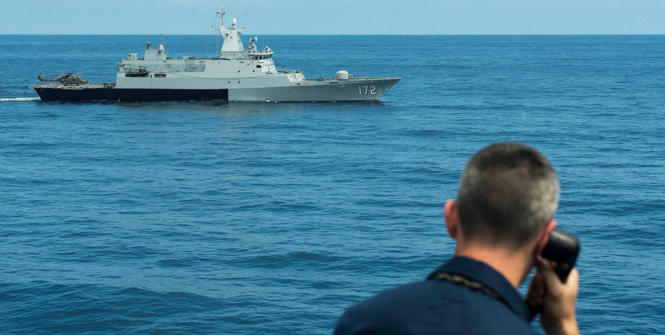What is China Doing in the South China Sea?

China’s militarisation of its claims in the South China Sea are an attempt to force ASEAN claimants into negotiating a resolution on Chinese terms and not according to international law, the United Nations Convention on the Law of the Sea (UNCLOS) and intra-ASEAN negotiation.
Since December 2013, China has engaged in controversial reclamation projects in the Spratly Islands. According to the Asia Maritime Transparency Initiative, seven reefs have been dredged and transformed into artificial islands with military facilities. On Fiery Cross Reef China has constructed a runway of 3,000 metres in length which can accommodate military as well as transport aircraft and two other airstrips have been constructed on Subi and Mischief Reefs. Harbour construction has been noted on Mischief Reef and Chinese naval vessels have visited the area suggesting that it may become a naval facility. On Johnson South Reef a multi-level facility with what looks like radar towers is under construction. This facility may turn out to be China’s monitoring station in the Spratly Islands, giving it the capacity to track the activities of the ASEAN claimants, as well as US overflights and navigation in the area.
Other claimants also have airstrips in the Spratly Islands; Vietnam has a short airstrip on Spratly Island, Taiwan as a strip on Itu Aba Island, Malaysia on Swallow Reef and the Philippines has a runway on Pagasa Island. The Chinese claim that what they are doing is not illegal and that they are simply doing what others have done. Vietnam, Malaysia and the Philippines have built facilities on features they have occupied and have engaged in similar reclamation activities, though not on the scale of the Chinese. What indeed is the fuss?
The ASEAN claimants have learned to live with each other and do not challenge each other’s claim. Vietnam has extensive claims to the South China Sea which overlap with those of China, Malaysia, and the Philippines, but its need for ASEAN support means it will not dispute the claims of its fellow ASEAN members. Malaysian and Philippine claims overlap and though there was tension between them in the past, China’s activities have obliged them to downplay their differences. The Malaysian claim also overlaps with that of Brunei which led to some differences over the granting of oil exploration rights in the past but these have since been resolved.
If the South China Sea dispute concerned only the ASEAN claimants it probably would have been resolved on the basis of international law, UNCLOS and intra-ASEAN negotiation. However, a legal resolution of this kind would leave China on the sidelines. China may be able to claim the Paracel Islands on the basis of effective occupation but aside from the features it occupies its claim to the Spratly Islands is dubious. International law favours the ASEAN claimants who occupy features there; Vietnam in particular is in possession of at least 21 features, the Philippines occupies seven and Malaysia five.
In this situation, China’s reclamation activities are part of an effort to force its claim to the area. With the airfields it has constructed there China will be able bring down airpower from its bases on Hainan and Woody Islands to provide air cover for its maritime activities in the South China Sea, something it could not do before. The Chinese will deploy SU-27 maritime fighters from these bases in the North to the Spratlys on rotation and will then be able to intimidate the ASEAN claimants into negotiating a resolution of the issue on Chinese terms. The Chinese would not attempt to eject the Vietnamese from the islands they have occupied in the Spratlys – that would be far too risky – but they would press them to come to terms. That would mean not only accepting Chinese sovereignty over both the Paracels and the Spratlys but conceding fishing, oil surveying, exploration and extraction rights to China as well. In the same way, the Chinese hope to separate the Philippines from its US ally by showing that the Americans cannot help them. Malaysia also will not escape the consequences. Its leaders hoped that enthusiastic bandwagoning with Beijing would protect their oil fields in the South China Sea, but sometime in the future Beijing may assert that those fields are part of its claim.
Ultimately, it is in Australia’s interest to promote a resolution of the issue according to law, and not as a result of Chinese power. If Beijing invokes power in this dispute it will increasingly employ power in other areas of policy that would affect Australia. For this reason, Australia should support the US as it strengthens its security relations with the ASEAN claimants with the intention of boosting their confidence to resist Chinese pressure. At the same time all parties should be encouraged to seek a resolution of the maritime dispute according to international law and UNCLOS.
Leszek Buszynski is Professor and Lecturer at the National Security College at the Australian National University. This article can be republished under a Creative Commons License.




